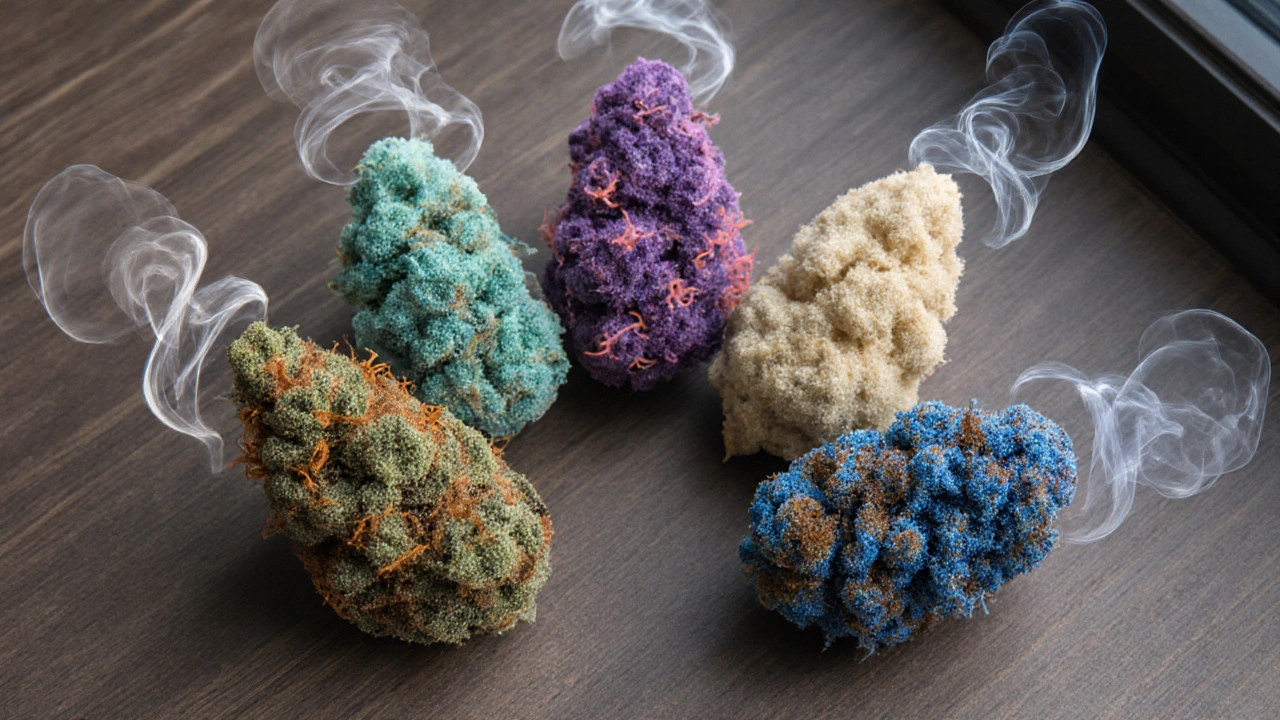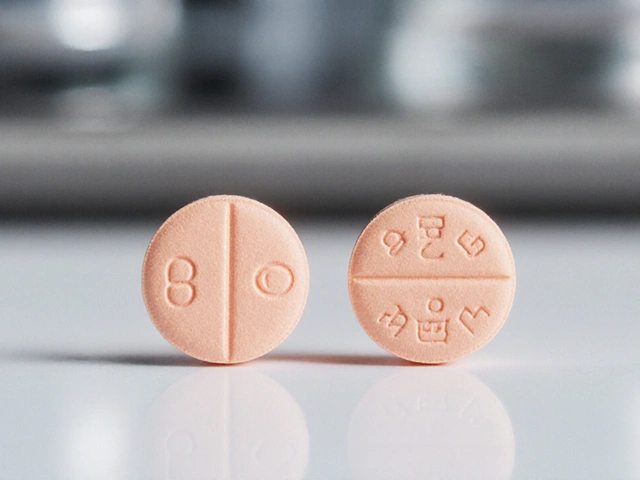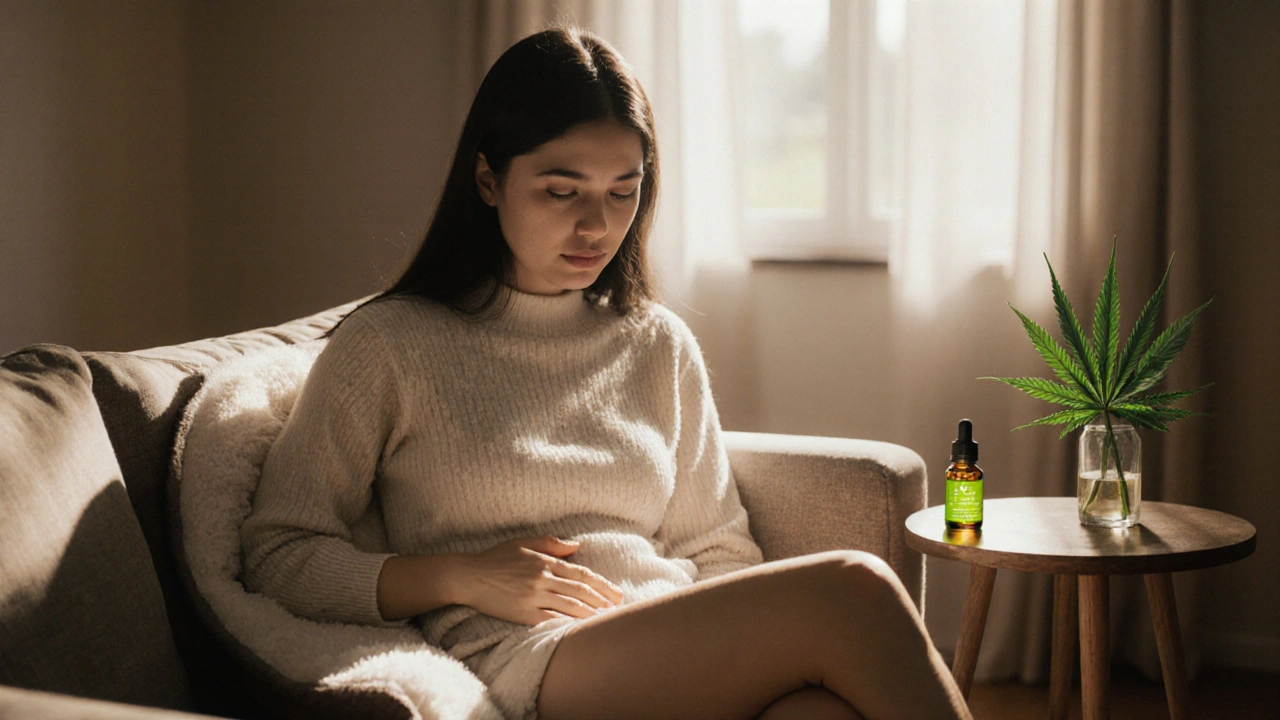Menstrual Cramp Relief Strain Selector
Choose your preference to find the best cannabis strains for menstrual discomfort relief
Important Note: Always start with a low dose (2-5mg CBD or 1-2% THC) and consult with a healthcare provider before using cannabis for medical purposes.
Every month, millions of people grapple with cramping, bloating, and that nagging ache that makes even simple tasks feel heavy. While heating pads and ibuprofen are go‑to options, an increasing number of women are turning to cannabis for a gentler, plant‑based relief. This guide breaks down why cannabis can help, which strains have the best science‑backed profiles, and how to use them safely during your cycle.
Key Takeaways
- THC and CBD work together with specific terpenes to calm uterine muscle spasms and lower inflammation.
- Five strains consistently show low‑to‑moderate THC, high CBD, and terpene blends rich in myrcene, linalool, and beta‑caryophyllene.
- Choose a delivery method (vape, tincture, edible) that matches your pain level and lifestyle.
- Start low, go slow: a 2‑5mg CBD dose or a 1‑2% THC inhalation is enough for most beginners.
- Watch for side effects such as dry mouth or mild dizziness, and avoid use if you’re pregnant or nursing.
Why Cannabis Helps Menstrual Pain
The uterus contracts during menstruation to shed its lining. In some people, the prostaglandin surge that drives these contractions is excessive, leading to sharp cramps. The body’s endocannabinoid system (a network of receptors that modulates pain, inflammation, and mood) can temper this response.
THC binds primarily to CB1 receptors in the nervous system, dulling pain signals and relaxing smooth muscle. CBD, on the other hand, has a low affinity for CB1/CB2 but influences them indirectly, reducing inflammation and anxiety. When THC and CBD are paired, they produce the so‑called “entourage effect,” where each compound boosts the other's therapeutic action.
Terpenes - the aromatic oils that give cannabis its smell - add another layer. Myrcene acts as a muscle relaxant, linalool has proven anti‑anxiety properties, and beta‑caryophyllene interacts with CB2 receptors to cut down inflammation. Together, they create a multi‑target approach that many find more effective than a single‑ingredient painkiller.

Top Strains for Period Discomfort
Below are the five strains that consistently rank highest for cramp relief based on user surveys, clinical anecdotes, and lab‑tested cannabinoid/terpene profiles.
Harlequin - A high‑CBD sativa‑dominant hybrid (CBD:THC ≈ 5:1). Lab reports show 10‑12% CBD, 1‑2% THC, and a terpene mix heavy on myrcene (0.5%) and caryophyllene (0.3%). The low THC keeps psychoactive effects minimal while the CBD calms uterine spasms.
- Best for: Day‑time use, mild to moderate cramps.
- Typical dose: 5‑10mg CBD via tincture or a small vape.
ACDC - A legendary CBD‑rich phenotype (CBD:THC up to 20:1). Average 15‑18% CBD, <1% THC, and a terpene profile dominated by myrcene and pinene. Its ultra‑low THC makes it ideal for those who want pain relief without any “high.”
- Best for: Sensitive users, night‑time relief.
- Typical dose: 10‑15mg CBD tincture before bed.
Girl Scout Cookies (GSC) - A balanced 1:1 hybrid (≈12% THC, 12% CBD) with a sweet, earthy aroma. Terpenes include linalool (0.4%) and humulene (0.2%). The mix of THC and CBD offers both pain‑killing and anti‑inflammatory actions.
- Best for: Moderate cramps, when a mild euphoric lift helps mood.
- Typical dose: 2‑3% THC vapor inhalation or 5‑7mg CBD+THC tincture.
Vanilla Kush - Indica‑dominant (≈8% THC, 6% CBD) with a soothing vanilla‑spice scent. High in linalool (0.6%) and beta‑caryophyllene (0.5%) which together target inflammation and muscle tension.
- Best for: Evening use, deep relaxation before sleep.
- Typical dose: 1‑2% THC vape or 0.5g of flower in a pipe.
Blue Dream - A sativa‑dominant hybrid (≈12% THC, 2% CBD) famous for its balanced high. Terpenes feature myrcene (0.4%) and pinene (0.3%), which help with both pain and mental fog.
- Best for: Day‑time activities when you need focus and pain relief.
- Typical dose: 2‑3% THC vapor or 5mg THC tincture.
Side‑by‑Side Strain Comparison
| Strain | THC % | CBD % | Dominant Terpenes | Preferred Time | Typical Dose |
|---|---|---|---|---|---|
| Harlequin | 1‑2 | 10‑12 | Myrcene, Caryophyllene | Day | 5‑10mg CBD |
| ACDC | <1 | 15‑18 | Myrcene, Pinene | Night | 10‑15mg CBD |
| Girl Scout Cookies | 12 | 12 | Linalool, Humulene | Either | 5‑7mg mix |
| Vanilla Kush | 8 | 6 | Linalool, Caryophyllene | Evening | 1‑2% THC vape |
| Blue Dream | 12 | 2 | Myrcene, Pinene | Day | 2‑3% THC vape |
Choosing the Right Strain for Your Cycle
Every body reacts differently, so consider these factors before picking a strain:
- Pain intensity: Mild cramps often respond to high‑CBD, low‑THC options like Harlequin or ACDC. Severe spasms may need a balanced 1:1 mix such as GSC.
- Time of day: If you need to stay productive, go for low‑THC or sativa‑leaning strains (Harlequin, Blue Dream). For bedtime, an indica‑heavy option (Vanilla Kush) eases both pain and sleep.
- Legal limits: In the UK, THC concentrations above 0.2% are illegal for recreational use, so most consumers stick to CBD‑rich varieties or medical‑grade products with a prescription.
- Delivery method: Vaporizers give rapid onset (5‑10minutes) and precise dosing, while tinctures allow for sub‑lingual absorption over 15‑30minutes. Edibles take longer (30‑90minutes) but provide longer‑lasting relief.
- Personal tolerance: New users should start with 2‑5mg of CBD or 1‑2% THC and wait at least 30minutes before taking more.

Safety, Side Effects, and Contra‑indications
Cannabis is generally well‑tolerated, but be aware of common side effects:
- Dry mouth - keep water handy.
- Dizziness or light‑headedness - sit or lie down if it happens.
- Temporary anxiety - choose low‑THC strains and avoid high‑dose vaping.
Never combine high‑THC cannabis with alcohol or other sedatives without medical guidance. Pregnant, nursing, or anyone on blood‑thinners should consult a healthcare professional before use.
Integrating Cannabis Into Your Period‑Care Routine
For best results, pair cannabis with other self‑care practices that naturally reduce cramp severity:
- Heat therapy: A warm pad before you inhale a few puffs can synergistically relax uterine muscles.
- Light exercise: Gentle yoga or a short walk boosts circulation, making cannabinoid absorption more efficient.
- Hydration and magnesium: Staying hydrated and eating magnesium‑rich foods (leafy greens, nuts) supports muscle relaxation alongside cannabis.
- Mindful breathing: Deep diaphragmatic breathing reduces stress, which in turn lessens the perception of pain.
Track your experience in a simple journal: note the strain, dose, timing, and pain level on a 1‑10 scale. Over a few cycles you’ll spot patterns and fine‑tune the regimen.
Frequently Asked Questions
Can I use over‑the‑counter CBD oil for menstrual cramps?
Yes. Broad‑spectrum or full‑spectrum CBD oils with 0% THC are legal in the UK and often provide enough anti‑inflammatory effect to lessen cramp intensity. Aim for 5‑10mg per dose and increase gradually if needed.
Is smoking cannabis safe during my period?
Smoking introduces tar and other irritants, which can aggravate respiratory issues. Vaporizing flower or using tinctures is a cleaner alternative that still delivers fast relief.
How long does the pain‑relieving effect last?
Low‑THC, high‑CBD strains usually provide 3‑4hours of relief. Higher‑THC options can last 5‑7hours, especially when taken as an edible.
Will cannabis affect my hormone levels?
Current research shows no lasting impact on estrogen or progesterone when used short‑term. Chronic, heavy use may influence menstrual regularity, so keep usage moderate.
Do I need a prescription to buy these strains in the UK?
Only THC‑containing products above the 0.2% legal limit require a medical prescription. CBD‑rich strains like Harlequin and ACDC can be bought from licensed shops without a prescription.
By understanding how cannabinoids, terpenes, and your own body interact, you can pick a strain that turns a painful period into a more manageable experience. Remember: start low, stay consistent, and combine cannabis with wholesome self‑care habits for the best results.






9 Comments
Hey folks, if you’re trying Harlequin for cramps, start with a tiny vape puff – about 2‑3 seconds – and see how you feel 😊. It’s enough to get the myrcene working without getting too high. Remember to hydrate, too!
Honestly, the real game‑changer is the CBD‑dominant profile; THC can make you jittery when you’re already uncomfortable. You deserve relief without the buzz, so prioritize strains like ACDC that keep THC under 1 %.
When we talk about menstrual discomfort, the underlying physiology involves prostaglandin‑induced uterine hypercontractility, which can be surprisingly intense for many people. The endocannabinoid system, with its CB1 and CB2 receptors, provides a natural modulatory pathway that can dampen this contraction cascade. THC binds chiefly to CB1 receptors in the central nervous system, attenuating the perception of pain and simultaneously relaxing smooth muscle fibers. CBD, while having low direct affinity, indirectly enhances the signaling of endocannabinoids and down‑regulates inflammatory cytokines, offering a complementary anti‑inflammatory effect. Terpenes such as myrcene act synergistically as muscle relaxants, whereas linalool contributes anxiolytic benefits that can reduce the perception of pain. In practice, this means that a strain with a balanced CBD‑to‑THC ratio, bolstered by a myrcene‑rich terpene profile, addresses both the source of cramping and the associated discomfort. Harlequin, with its approximate 5:1 CBD‑to‑THC ratio and notable myrcene content, is frequently cited in user surveys as effective for mild to moderate cramps. For more severe pain, ACDC’s even higher CBD ratio (up to 20:1) can provide relief without noticeable psychoactive effects, making it suitable for daytime use. Delivery method matters: vaping offers rapid onset, tinctures provide precise dosing, and edibles grant longer‑lasting relief but with delayed onset. A low initial dose-2‑5 mg of CBD or 1‑2 % THC inhalation-is advisable to gauge individual tolerance. Monitoring how your body reacts over the first few cycles can guide incremental adjustments. It’s also wise to pair cannabinoid therapy with conventional self‑care measures, such as heat therapy and gentle stretching, to maximize overall comfort. Though anecdotal evidence is promising, rigorous clinical trials remain limited, so personal experimentation under medical guidance is prudent. Finally, staying informed about local regulations ensures you access products that are lab‑tested and accurately labeled, safeguarding both efficacy and safety.
Take it in the morning with a light tincture and you’ll notice the muscle tension easing before your coffee even hits.
One practical tip is to keep a dosage journal; noting the strain, amount, and how you felt can help you fine‑tune the perfect regimen for each phase of your cycle.
While the article offers a decent overview, it regrettably omits a critical discussion of the pharmacokinetic variability inherent to oral versus inhalational routes, which can dramatically alter plasma concentrations and thus therapeutic outcomes. Moreover, the reliance on anecdotal surveys without citing peer‑reviewed studies undermines the scientific rigor that a topic of this clinical relevance demands. A more meticulous exposition would juxtapose the cannabinoid‑terpene synergy with quantitative data from controlled trials, if available, thereby providing readers with an evidence‑based framework rather than a mere list of popular strains.
The “entourage effect” hype often overshadows the fact that dosage precision is paramount; without it, you risk either no relief or unwanted psychoactivity.
Meh.
It is essential to recognize that not every high‑CBD strain is created equal; the terpene matrix can make all the difference in therapeutic potency.